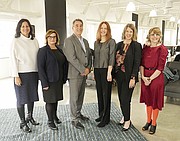RETAIL
What’s Next for the L.A. Fashion District and the California Market Center?
A renaissance is brewing in the Los Angeles Fashion District with the California Market Center and Los Angeles Street forecast to be major hubs in the area.
David Foley, vice president of operations for the CMC showroom building, and other speakers painted a picture of a vibrant future for the neighborhood that is home to fabric emporiums, men’s suiting stores and Santee Alley, where bargain hunters comb the narrow passage for off-price goods.
At a May 16 annual meeting of the Fashion District Business Improvement District, a number of projects were outlined that will play a part in the district’s redevelopment.
The CMC is currently undergoing a $170-million renovation that Foley expects to be completed by the end of 2020. The CMC’s C Building, which faces Olympic Boulevard and whose renovation should be complete by the end of this year, will be devoted to fashion showrooms. Until recently, fashion showrooms were the primary business of the CMC, which encompasses three buildings that are each 13 stories high.
The CMC’s A and B buildings will be devoted to creative office space. New looks will include six open-air bridges between the A and B buildings, where tenants can enjoy the sun and a 5,000-square-foot rooftop space for gatherings. The remodel will feature 150,000 square feet of retail space, including dining outposts open to the public.
In the past, the more-than-50-year-old CMC developed a reputation for being closed off to the district, but Foley believes the CMC will be at the center of all the action taking place in this burgeoning area.
More than a decade ago, Foley was working to revamp Brookfield Properties’ Fig@7th retail center. He said that downtown Los Angeles had overcome a number of hurdles. “We don’t have to hard sell anymore. There is greater interest in downtown Los Angeles,” he said.
For more than 80 years, downtown’s Fashion District has been the center primarily for apparel manufacturing, showrooms and apparel-centric shops. But in recent years the area—particularly the intersection of 9th Street and Broadway—has become the address for some high-end boutiques. It was a big change for the neighborhood. And more changes are coming.
Los Angeles Street hub
Planners from Los Angeles City Hall are working to bring more housing to the Fashion District. It’s part of the city Planning Department’s DTLA 2040 Plan, which forecasts more than 252,000 people will be living in downtown in 20 more years. That is triple the number of people—around 76,000—currently estimated to be living in the area.
Shana Bonstin, a deputy director of the city Planning Department, said the city wants to increase affordable housing and relax zoning limits on where people can live in downtown. Currently, more than 30 percent of the downtown area is zoned for housing. By 2040, Bonstin said 60 percent will be zoned for housing.
The Planning Department also is revising some guidelines on the city’s density limits. Los Angeles’ zoning codes, written in 1946, are being rewritten to reflect the demands of a much different time and city that has drastically changed. A new environmental impact report, which will be a guide for development, is scheduled to be released this fall.
In the recent past, Los Angeles Street was a hub for purveyors of discount men’s suits, such as Academy Awards Clothes, which closed in 2008 after a 58-year run. Shoppers can still buy a discounted suit on the street, but the Fashion District BID is cultivating a new outlook and view for the thoroughfare.
Clare Sebenius and Genevieve Haines of Haines & Co., a public relations and marketing firm, said that eventually Los Angeles Street will blossom into a more pedestrian-friendly area with a diversity of tenants and businesses.
Tenants will not only include fashion retailers but also more restaurants, businesses and residences. A way to accomplish a more vibrant Los Angeles Street will be to improve street lighting and develop better signage for the corridor, Haines and Sebenius said.
One mark of the Fashion District’s growth is the amount of trash that is collected in the area. Currently, 14 tons of trash is collected in the district every day, said Rena Leddy, the executive director of the Fashion District BID. A few years ago, a mere six tons of trash was collected daily.






















